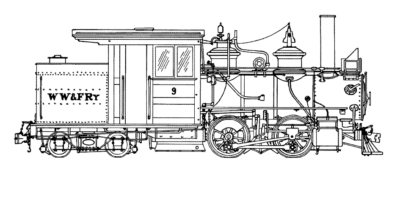What is a Maine Two-Footer
In an age when railroads meant prosperity, thrifty New Englanders decided any railroad was better than none. The result was a group of railroads virtually unique to Maine. To reduce costs, the tracks were built with rails so close together a pair of size 12 shoes set “heel-to-toe” could span the distance. At their zenith, these lines operated over 200 miles of track, ran dozens of locomotives, carried thousands of passengers, and hauled countless tons of freight. The last line closed in 1943. Most of the lines became the victims of competition with trucks.
These railroads, built to the gauge of just two feet, were cheaper to build than the “standard gauge” railroads of four foot, eight and one-half inches. The term “gauge” refers to the distance between the inside edges of both rails. This means that the “Two-Footers” are less than half the size of their standard gauge counterparts, and that all the earthworks and components used to build the railroad could be smaller and less expensive. However small these diminutive railroads were, they worked just as hard if not harder than their larger brethren, right up until the end.
